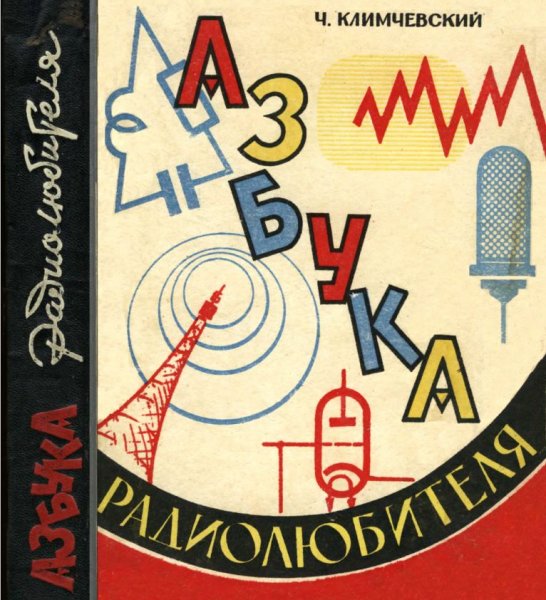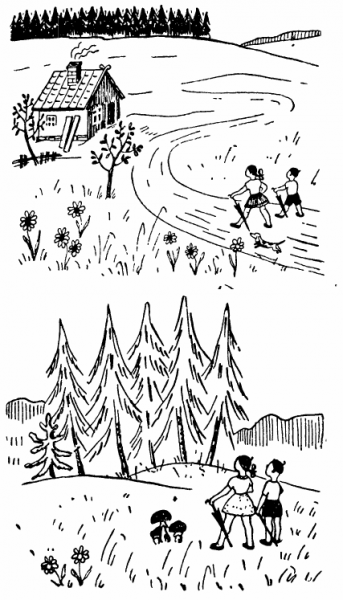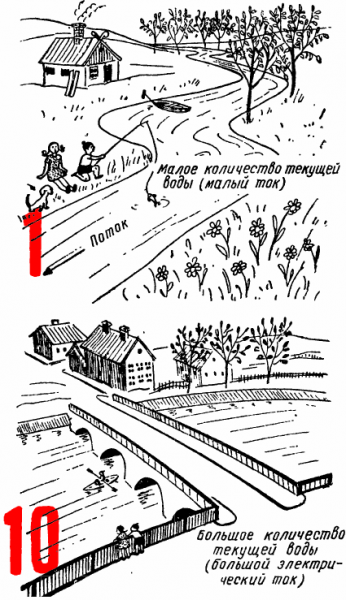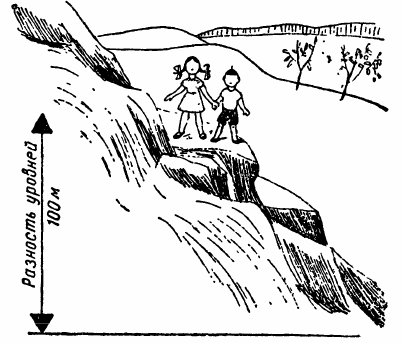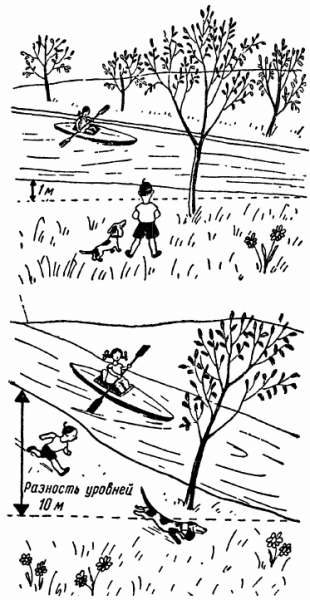About electric current, voltage and power from a Soviet children's book: simple and clear
In the Soviet Union, which achieved very serious successes in the development of science and technology, the radio amateur movement became widespread. Many thousands of young citizens have studied radio engineering under the guidance of instructors in radio circles and radio clubs that have special technical literature, tools and instruments. Many of them in the future became qualified engineers, designers, scientists.
Popular scientific literature was published for such radio circuits, in which various issues of physics, mechanics, electrical engineering and electronics were explained in simple language with a large number of illustrations.
One of the examples of such books is Cheslov Klimchevsky's book "The Alphabet of a Radio Amateur", published by the publishing house "Svyazizdat" in 1962. The first section of the book is called "Electrical Engineering", the second section is "Radio Engineering", the third is "Practical Advice". , the fourth section — «We install ourselves».
The book itself can be downloaded here: The Amateur Radio Alphabet (wild)
This type of book in the 1960s did not belong to highly specialized literature.They were issued in circulations of tens of thousands of copies and were intended for a mass reader.
The Raz radio was applied so completely in people's daily lives, so at the time it was believed that you could not be limited only by the ability to turn the knobs. Nika. And every educated person should study radio in order to understand how radio transmission and radio reception are carried out, to get acquainted with the basic electrical and magnetic phenomena that are the key to the theory of radio engineering. It is also necessary, generally speaking, to become familiar with the systems and design of receiving devices.
Let's look together and judge how at that time they knew how to explain complex things with simple pictures.
A novice radio amateur of our time:
About electric current
All substances in the world and, accordingly, all objects around us, mountains, seas, air, plants, animals, people, consist of immeasurably small particles, molecules, and the latter, in turn, of atoms. A piece of iron, a drop of water, an insignificant amount of oxygen, are an accumulation of billions of atoms, one kind in iron, another in water or oxygen.
If you look at the forest from a distance, it looks like a dark strip that is one piece (compare it, for example, with a piece of iron). As they approach the edge of the forest, individual trees can be seen (in a piece of iron — iron atoms). A forest consists of trees; similarly, a substance (such as iron) is made up of atoms.
In a coniferous forest, the trees are different than in a deciduous forest; likewise, the molecules of each chemical element are composed of atoms different from the molecules of other chemical elements. So, iron atoms are different from, say, oxygen atoms.

Approaching even closer to the trees, we see that each of them consists of a trunk and leaves. In the same way, the atoms of the substance consist of the so-called Nucleus (trunk) and electrons (sheets).
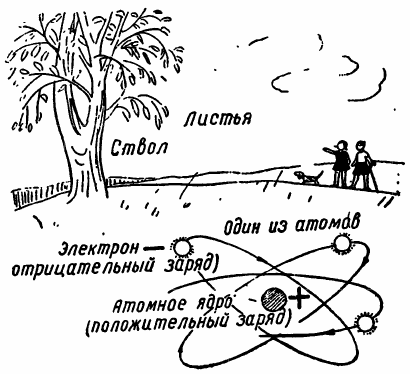
The trunk is heavy and the core is heavy; it represents the positive electrical charge (+) of the atom. Leaves are light and electrons are light; they form a negative electrical charge (-) on the atom.
Different trees have trunks with different numbers of branches and the number of leaves is not the same. Likewise, an atom, depending on the chemical element it represents, consists (in its simplest form) of a nucleus (trunk) with several positive charge — the so-called protons (branches) and a number of negative charges — electrons (sheets).
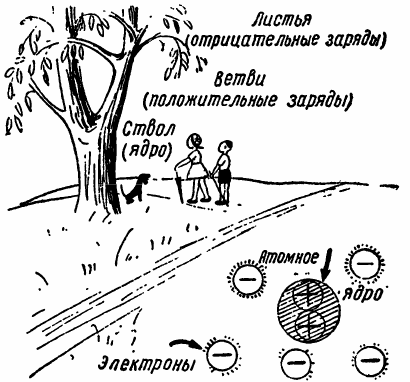
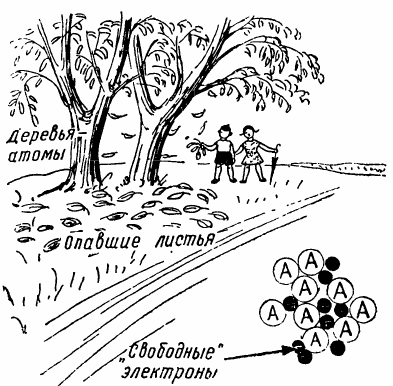
In the forest, on the ground between the trees, many fallen leaves accumulate. The wind lifts these leaves from the ground and they circulate among the trees. So in a substance (for example, a metal) among individual atoms there is a certain amount of free electrons that do not belong to any of the atoms; these electrons move randomly among the atoms.
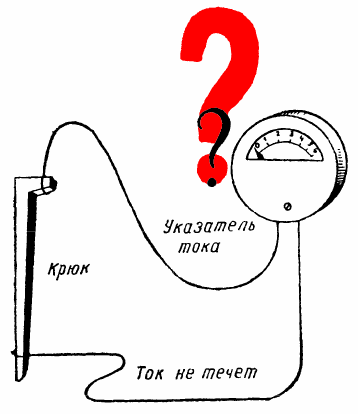
If you connect the wires coming from an electric battery to the ends of a piece of metal (for example, a steel hook): connect one end of it to the plus of the battery — bring the so-called positive electric potential (+) to it, and the other end to the minus of the battery — bring negative electric potential (-), then the free electrons (negative charges) will begin to move between the atoms inside the metal, rushing to the positive side of the battery.
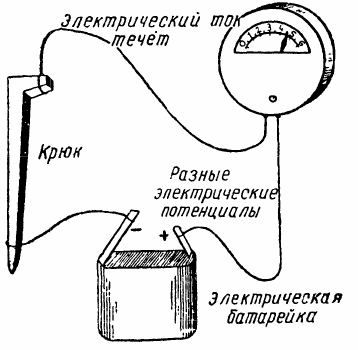
This is explained by the following property of electric charges: opposite charges, that is, positive and negative charges attract each other; like charges, that is, positive or negative, on the contrary, repel each other.
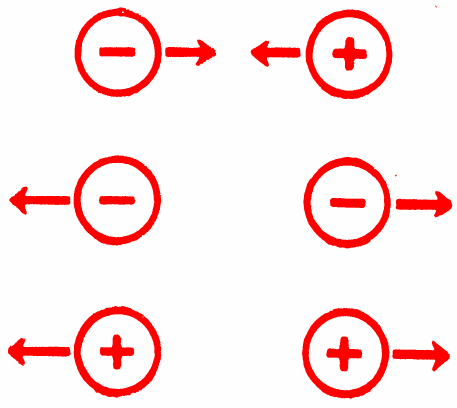
Free electrons (negative charges) in the metal are attracted to the positively charged (+) terminal of the battery (source of current) and therefore move in the metal no longer randomly, but to the plus side of the current source.
As we already know, an electron is an electric charge. A large number of electrons moving in one direction inside the metal make up the electron flow, i.e. electrical charges. These electric charges (electrons) moving in the metal form an electric current.
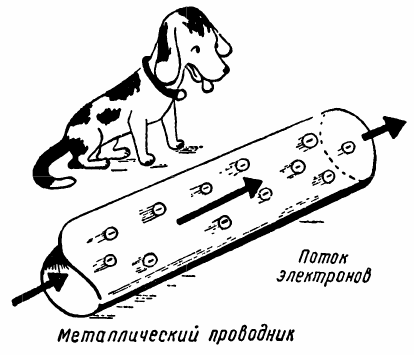
As already mentioned, electrons move along wires from minus to plus. However, we agreed to consider that the current flows in the opposite direction: from plus to minus, that is, as if not negative, but positive charges move along the wires (such positive charges would be attracted to the minus of the current source).
The more leaves in the forest are driven by the wind, the thicker they fill the air; likewise, the more charges flow in the metal, the greater the amount of electric current.
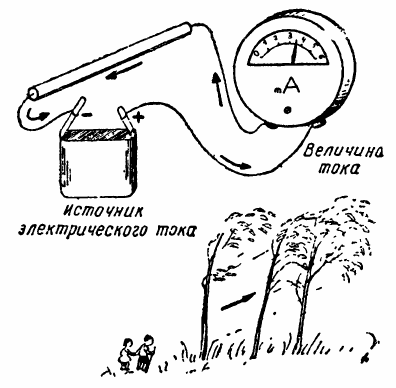
Not every substance can carry an electric current with the same ease. Free electrons move easily, for example in metals.
Materials in which electric charges move easily are called conductors of electric current. Some materials, called insulators, have no free electrons and therefore no electric current flows through the insulators. Insulators include, among other materials, glass, porcelain, mica, plastics.
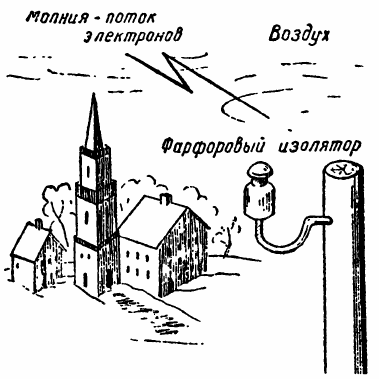
The free electrons that are present in a substance that conducts an electric current can also be compared to water droplets.
Individual droplets at rest do not create a water flow. A large number of them in motion form a stream or river flowing in one direction. The drops of water in this stream or river move in a flow whose force is greater, the greater the difference in the levels of the channel along its path and, therefore, the greater the difference in the "potentials" (heights) of the individual individuals segments of this path.
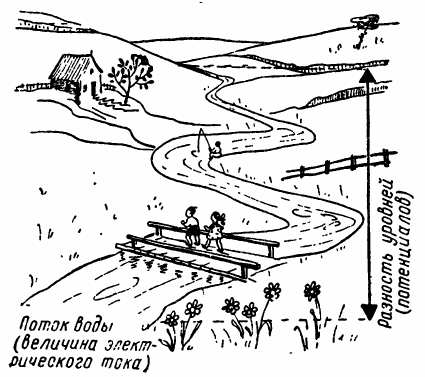
The magnitude of the electric current
To understand the phenomena caused by electric current, compare it to the flow of water. Small amounts of water flow in streams, while large masses of water flow in rivers.
Assume that the value of water flow in the stream is equal to 1; Let us take the flow value in the river for example as 10. Finally, for a powerful river the water flow value is, say, 100, that is a hundred times the value of the flow in the stream.
A weak stream of water can drive the wheel of only one mill. We will take the value of this stream equal to 1.
Twice the flow of water can drive two of these mills. In this case, the water flow value is equal to 2.
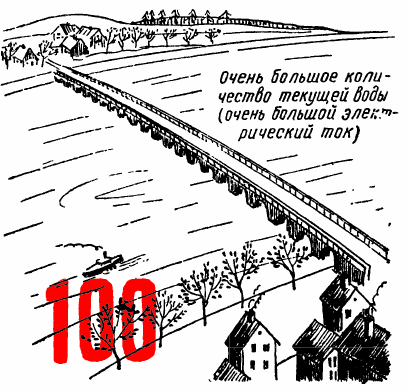
Five times the stream of water can drive five identical mills; the value of the water flow is now 5. The flow of the water flow in the river can be observed; electric current flows through wires invisible to our eyes.
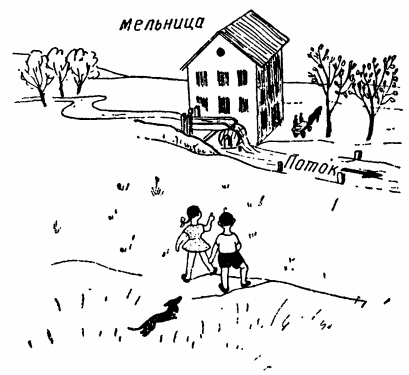
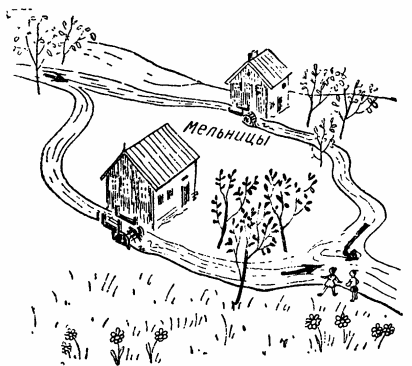
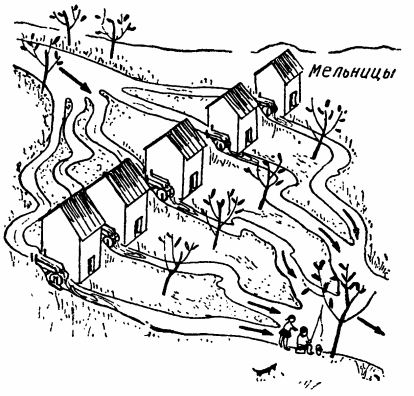
The following figure shows an electric motor (electric motor) driven by electric current. Let us take in this case the value of electric current equal to 1.
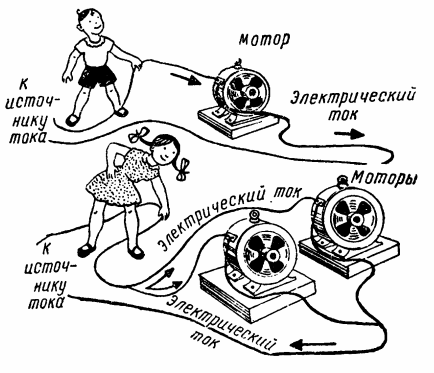
When an electric current drives two such electric motors, then the amount of current flowing through the main wire will be twice as large, that is, equal to 2.Finally, when an electric current feeds five of the same electric motors, then the current on the main wire is five times higher than in the first case; therefore its magnitude is 5.
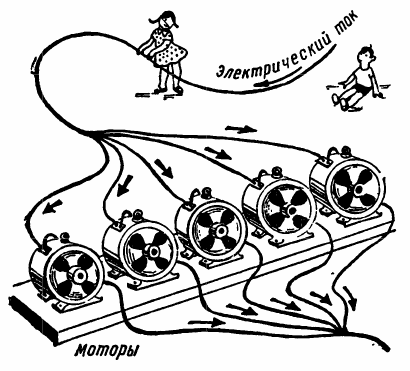
A practical unit for measuring the amount of flow of water or other liquid (that is, the amount of it flowing per unit of time, for example, per second, through the cross-section of a river bed, pipe, etc.) is liter per second.
To measure the magnitude of the electric current, that is, the amount of charges flowing through the cross section of the wire per unit time, the ampere is taken as a practical unit. Thus, the magnitude of the electric current is determined in amperes. The abbreviated ampere is indicated by the letter a.
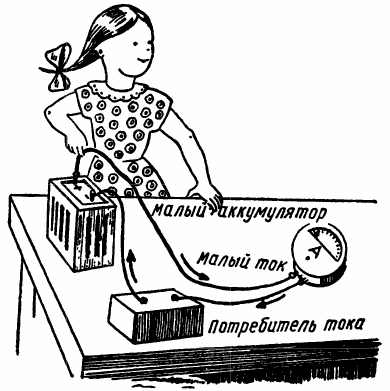
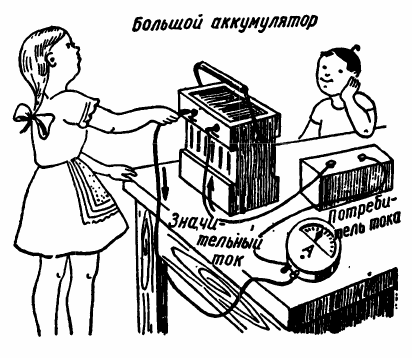
The source of electric current can be, for example, a galvanic battery or an electric accumulator.
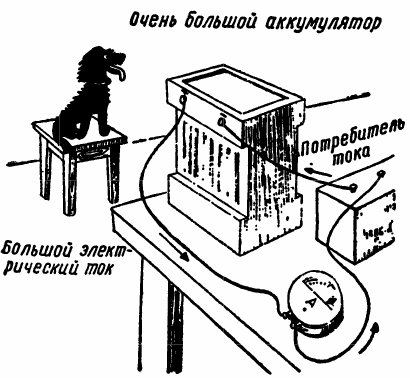
The size of the battery or accumulator determines the amount of electric current they can provide and the duration of their action.
To measure the magnitude of electric current in electrical engineering, use special devices, ammeters (A). Different electrical devices carry different amounts of electrical current.
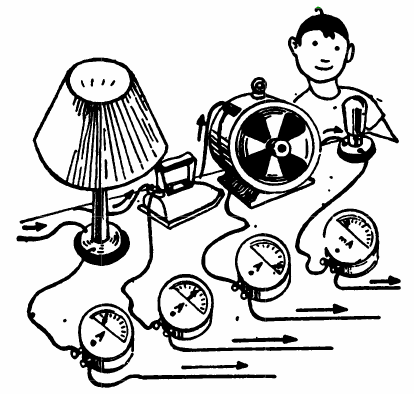
Voltage
The second electrical quantity closely related to the magnitude of current is voltage. To understand more easily what the voltage of an electric current is, let's compare it to the difference in the levels of the channel (the fall of the water in the river), just as we compared the electric current to the flow of water. With a small difference in channel levels, we will take the difference equal to 1.
If the difference in channel levels is more significant, then the water fall is correspondingly greater. Suppose, for example, that it is equal to 10, that is, ten times more than in the first case.Finally, with an even greater difference in water fall levels, it is, say, 100.
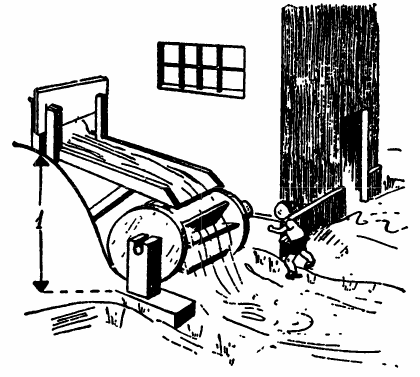
If the water stream falls from a small height, then it can drive only one mill. In this case, we will take a drop of water equal to 1.
The same stream falling from twice the height can turn the wheels of two similar mills. In this case, the water drop is equal to 2.
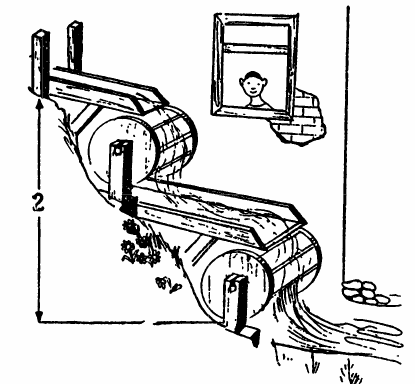
If the difference in channel levels is five times greater, then the same flow drives five such mills. The water drop is 5.
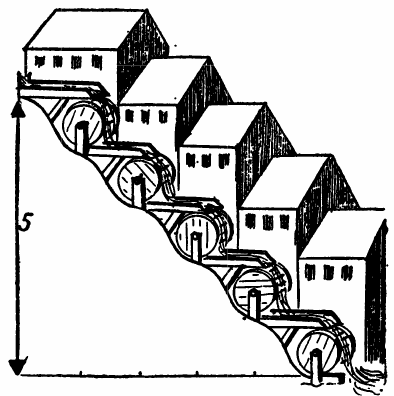
Similar phenomena are observed when considering electric voltage. It is enough to replace the term «water drop» with the term «electric voltage» to understand what it means in the following examples.
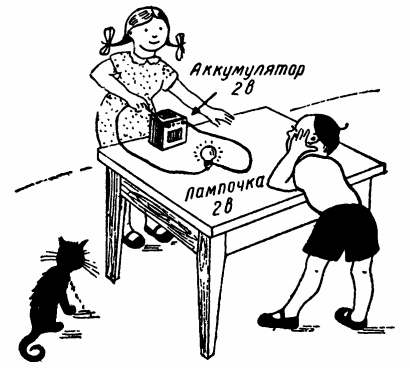
Let only one lamp burn. Suppose a voltage equal to 2 is applied to it.
In order for five such bulbs connected in the same way to burn, the voltage must be equal to 10.
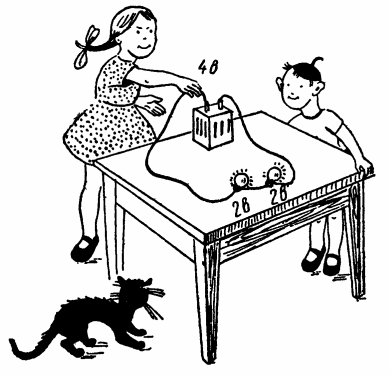
When two identical bulbs connected in series with each other are lit (as bulbs are usually connected in Christmas tree garlands), the voltage is 4.
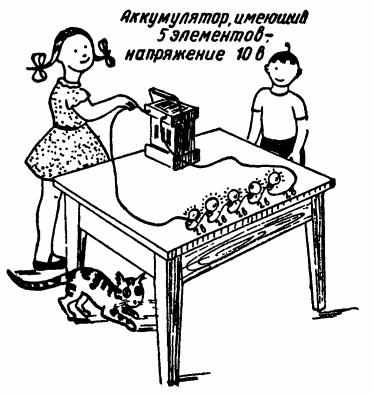
In all the cases considered, an electric current of the same magnitude passes through each bulb and the same voltage is applied to each of them, which is part of the total voltage (battery voltage), which is different in each individual example.
Let the river flow into the lake. Conditionally, we will take the water level in the lake as zero. Then the level of the river channel near the second tree in relation to the water level in the lake is equal to 1 m, and the level of the river channel near the third tree will be 2 m. The level of the channel near the third tree is 1 m higher than its level near the second tree, i.e. between these trees is equal to 1 m.
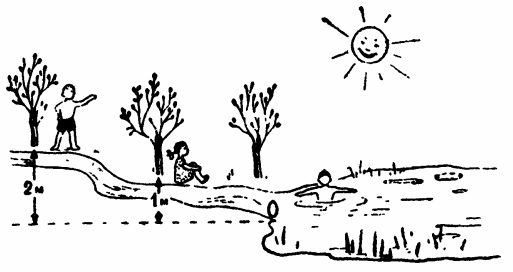
The difference in channel levels is measured in units of length, for example, as we did, in meters. In electrical engineering, the level of the river bed at any point with respect to a certain zero level (in our example the water level of the lake) corresponds to an electric potential.
The difference in electric potential is called voltage. Electric potential and voltage are measured by the same unit—the volt, abbreviated by the letter c. Thus, the unit for measuring electrical voltage is the volt.
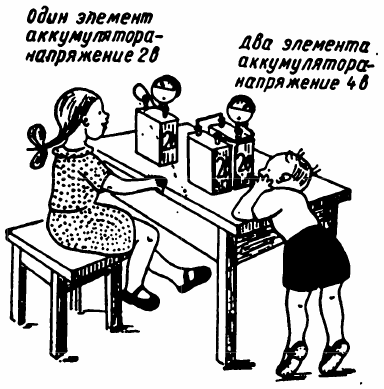
Special measuring devices called voltmeters (V) are used to measure electrical voltage.
Such a source of electric current as a battery is widely known. One cell of the so-called lead-acid battery (in which the lead plates are immersed in an aqueous solution of sulfuric acid) when charged has a voltage of about 2 volts.
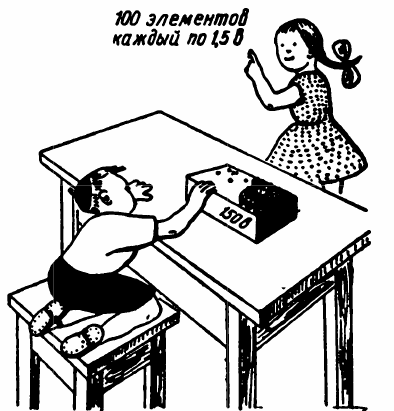
An anode battery, which is used to power battery radios with electric current, usually consists of several dozen dry galvanic cells, each with a voltage of about 1.5 V.
These elements are connected sequentially (that is, the plus of the first element is connected to the minus of the second, the plus of the second — to the minus of the third, etc.). In this case, the total voltage of the battery is equal to the sum of the voltages of the cells of which it is composed.
Therefore, a 150 V battery contains 100 such cells connected in series with each other.
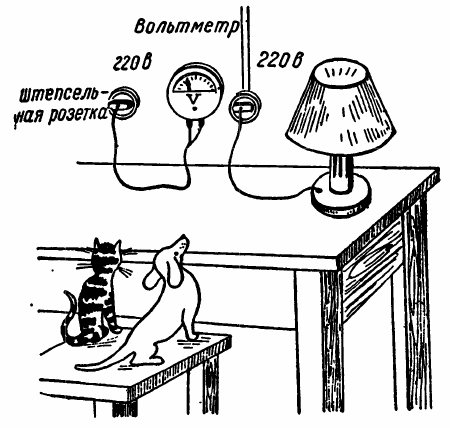
In the socket of the lighting network with a voltage of 220 V, you can plug in one incandescent bulb designed for a voltage of 220 V or 22 identical Christmas tree lights connected in series, each of which is designed for a voltage of 10 V.In this case, each bulb will have only 1/22 of the line voltage, that is, 10 volts.
The voltage acting on a particular electrical device, in our case a light bulb, is called the voltage drop. If a 220 V bulb consumes the same current as a 10 V bulb, then the total current drawn from the network by the garland will be the same in magnitude as the current flowing through the 220 V bulb.
From what has been said, it is clear that, for example, two identical 110-volt bulbs can be connected to a 220 V network, connected in series with each other.
It is possible to heat radio tubes designed for a voltage of 6.3 V, for example, from a battery consisting of three cells connected in series; lamps that are designed for a filament voltage of 2 V can be powered by a single cell.
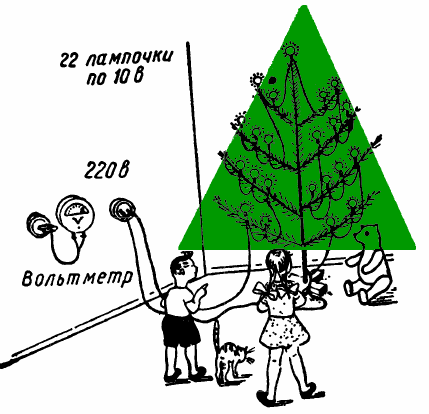
The filament voltage of radio electric tubes is indicated in rounded form at the beginning of the lamp symbol: 1.2 V — with the number 1; 4.4 in — number 4; 6.3 in — number 6; 5 c — number 5.
For the cause causing electric current
If two areas of the earth's surface, even far apart, lie at different levels, then water flow can occur. The water will flow from the highest point to the lowest.
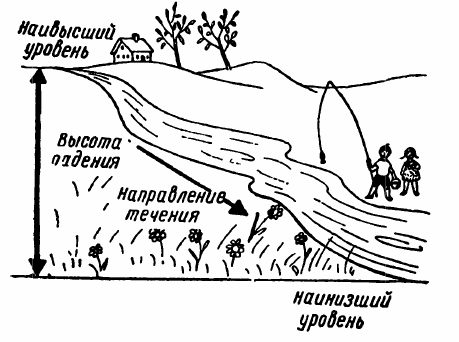
So is electric current. It can flow only if there is a difference in electrical levels (potentials). On a weather map, the highest barometric level (high pressure) is marked with a "+" sign and the lowest level with a "-" sign.
The levels will be aligned in the direction of the arrow. The wind will blow in the direction of the area with the lowest barometric level. When the pressure equalizes, the air movement will stop. Thus, the flow of electric current will stop if the electric potentials equalize.
During a thunderstorm there is an equalization of electrical potentials between the clouds and the ground or between the clouds. Appears in the form of lightning.
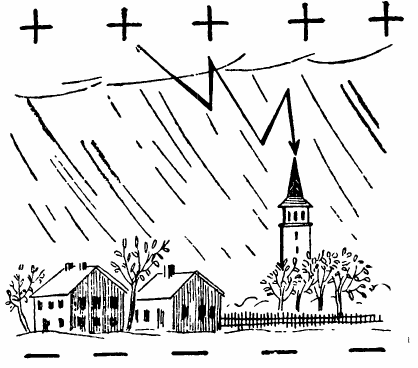
There is also a potential difference between the terminals (poles) of each galvanic cell or battery. Therefore, if you attach, for example, a light bulb to it, then current will flow through it. Over time, the potential difference decreases (potential equalization occurs) and the amount of current flowing also decreases.
If you plug a light bulb into the mains, then an electric current will also flow through it, as there is a potential difference between the sockets of the outlet. However, unlike a galvanic cell or battery, this potential difference is maintained constantly — as long as the power plant is running.
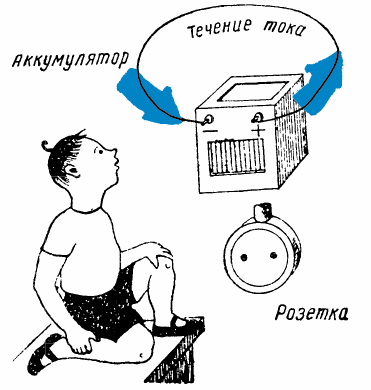
Electrical energy
There is a close relationship between electrical voltage and current. The amount of electrical power depends on the amount of voltage and current. Let us explain this with the following examples.
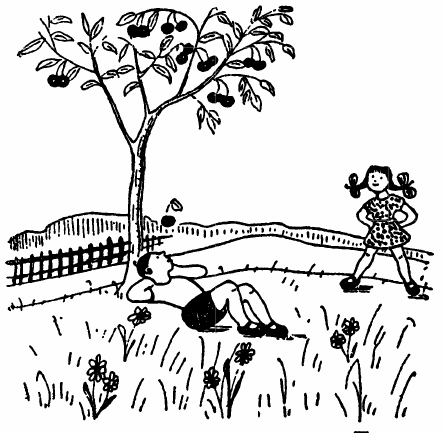
Cherry falls from a low height: Low height - slight tension. Low impact force — low electrical power.
A coconut falls from a small height (relative to where the boy climbed): Large object - large current. Low altitude — low stress. Relatively high impact force — relatively high power.
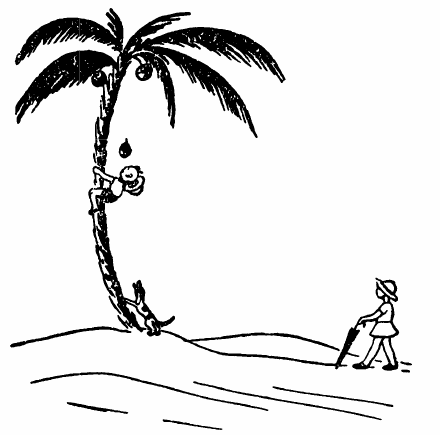
A small flowerpot falls from a great height: A small object is a small current. The great height of the fall is great stress. High impact force — high power.
Avalanche falling from a great height: Large masses of snow — a large current. The great height of the fall is great stress. The great destructive power of an avalanche is great electrical power.
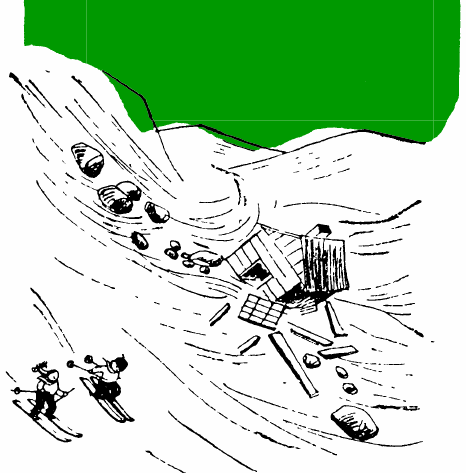
At high current and high voltage, large electrical power is obtained.But the same power can be obtained with higher current and correspondingly lower voltage or, conversely, with lower current and higher voltage.
Direct current electrical power is equal to the product of the voltage and current values. Electrical power is expressed in watts and is denoted by the letters W.
It has already been said that a water flow of a certain magnitude can drive one mill, twice the flow - two mills, four times the flow - four mills, etc., despite the fact that the water drop (voltage) will be the same.
The figure shows a small flow of water (corresponding to an electric current) turning the wheels of four mills due to the fact that the water drop (corresponding to an electric voltage) is large enough.
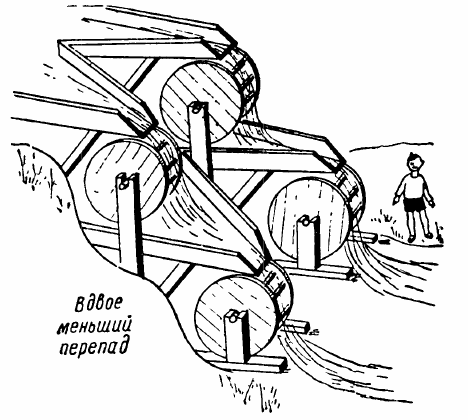
The wheels of these four mills can turn with twice the flow of water at half the height of the fall. Then the mills would be arranged slightly differently, but the result would be the same.
The following figure shows two lamps connected in parallel to a 110V lighting network. A current of 1 A flows through each of them. The current flowing through the two lamps is a total of 2 amperes.
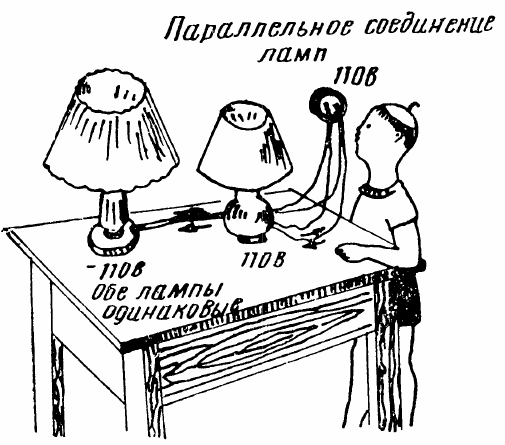
The product of the voltage and current values determines the power that these lamps consume from the network.
110V x 2a = 220W.
If the voltage of the lighting network is 220 V, the same lamps must be connected in series, not in parallel (as it was in the previous example), so that the sum of the voltage drop on them is equal to the voltage of the network. The current flowing in this case through the two lamps is 1 A.
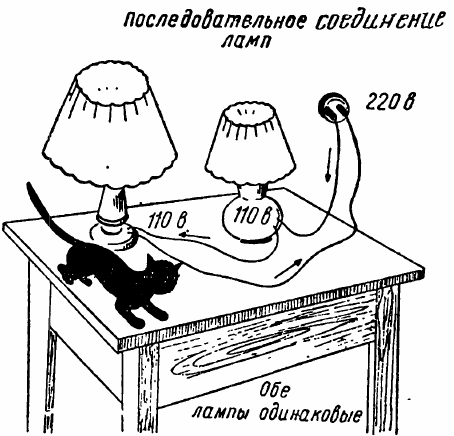
The product of the values of the voltage and the current flowing through the circuit will give us the power consumed by these lamps 220 V x 1a = 220 W, that is, the same as in the first case.This is understandable, since in the second case the current taken from the network is twice less, but twice the voltage in the network.
Watt, kilowatt, kilowatt hour
Any electrical device or machine (bell, light bulb, electric motor, etc.) consumes a certain amount of electrical energy from the lighting network.
Special devices called wattmeters are used to measure electrical power.
The power, for example, of a lighting lamp, an electric motor, etc., can be determined without the help of a wattmeter, if the mains voltage and the amount of current that flows through the consumer of electrical energy connected to the mains are known.
Similarly, if the grid power consumption and grid voltage are known, then the amount of current flowing through the consumer can be determined.
For example, a 110-volt lighting network includes a 50-watt lamp. What current flows through it?
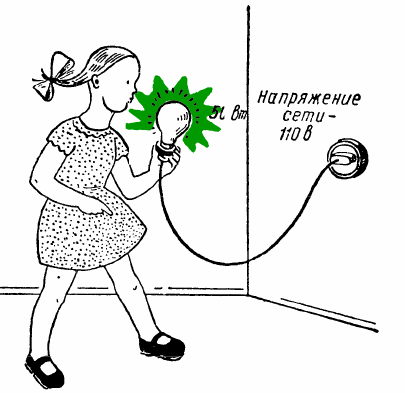
Since the product of the voltage expressed in volts and the current expressed in amperes is equal to the power expressed in watts (for direct current), then after making the reverse calculation, that is, divide the number of watts by the number of volts ( mains voltage), we get the amount of current in amperes flowing through the lamp,
a = w / b,
the current is 50 W / 110 V = 0.45 A (approx.).
Thus, a current of about 0.45 A flows through the lamp, which consumes 50 W of energy and is connected to a 110 V electrical network.
If a chandelier with four 50-watt bulbs, a table lamp with one 100-watt bulb and a 300-watt iron are included in the lighting network of the room, then the power of all energy consumers is 50 W x 4 + 100 W + 300 W = 600 W.
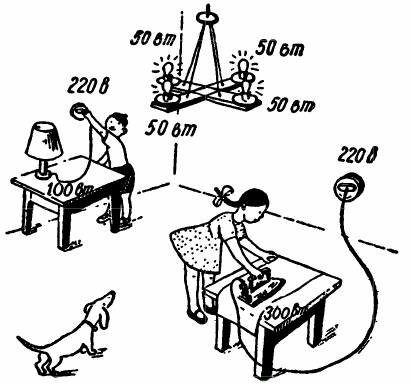
Since the mains voltage is 220 V, an electric current equal to 600 W / 220 V = 2.7 A (approximately) flows through the common lighting wires suitable for this room.
Let the electric motor consume 5000 watts of power from the network, or, as they say, 5 kilowatts.
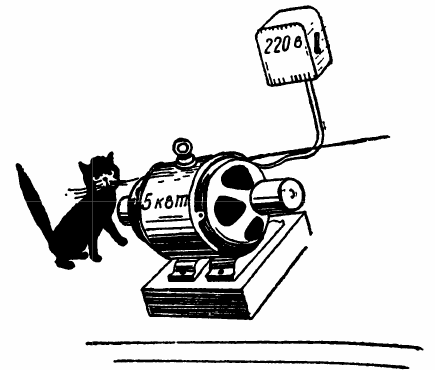
1000 watts = 1 kilowatt, just like 1000 grams = 1 kilogram. Kilowatts are abbreviated as kW. Therefore, we can say about the electric motor that it consumes a power of 5 kW.
To determine how much energy is consumed by any electrical device, it is necessary to take into account the length of time during which that energy was consumed.
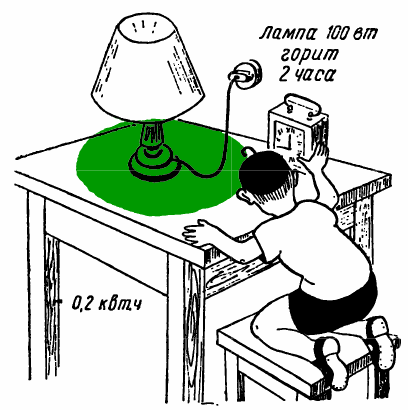
If a 10-watt light bulb is on for two hours, then the electrical energy consumption is 100 watts x 2 hours = 200 watt-hours or 0.2 kilowatt-hours. If a 100-watt light bulb is on for 10 hours, then the amount of energy consumed is 100 watts x 10 hours = 1000 watt-hours or 1 kilowatt-hour. Kilowatt hours are abbreviated as kWh.
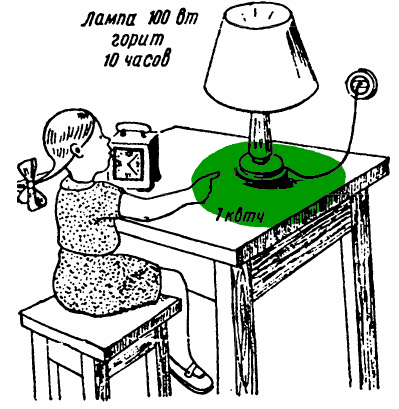
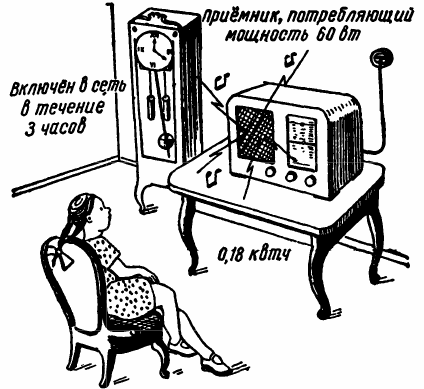
There are many more interesting things in this book, but even these examples show how responsibly and sincerely the authors of that time approached their work, especially in the case of teaching children.

